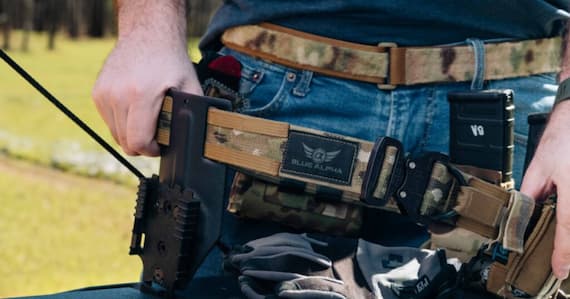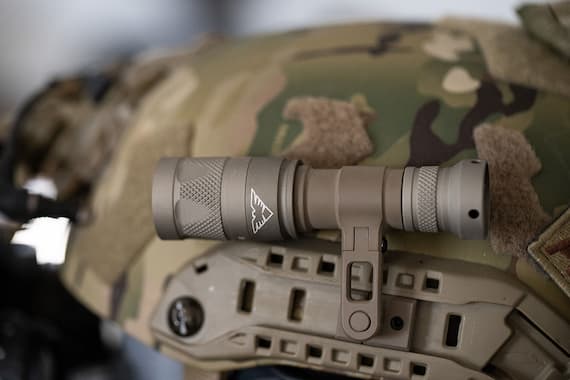Confidence in the field starts long before first light. It begins when every strap, clip and pocket sits exactly where you expect. Supplies might change, missions might shift, but reliable accessories keep your kit sharp and your mind on the task. The four items below have proven their worth from barracks halls to border crossings.
What Military Accessories Do You Need?
Nobody wants to haul extra ounces, yet leaving the right tool behind hurts more. The four items below strike a balance between weight, utility and long-term value.
Tactical Belt
Having a durable and comfortable military belt is the backbone of a fighting load. When your plate carrier comes off at the gate or you need to dump weight fast during a ruck rest, the belt keeps side-arm, tourniquet, radio and multi-tool right where muscle memory expects them. Modern military belt designs borrow from climber-grade rescue rigs, blending two-layer scuba webbing with an inner hook-and-loop liner that anchors to your trousers. That structure stops sag without cutting circulation, even when you sprint a forty-meter dash in full kit.

Not all tactical belts are alike. Some troops pick a minimalist shooters’ belt for tight urban hallways, while convoy gunners reach for broader MOLLE sleeves to host dump bags and small med kits. If your unit prefers belt-only carriage on the range, look for an ANSI-rated quick-release buckle that sheds mud and ice yet still passes a one-handed pull test. Rappelling-qualified “rigger” styles add a forged D-ring rated to six thousand pounds, useful for emergency belt extractions or ad-hoc anchor points during vehicle recovery drills.
Material choices matter: mil-spec nylon shrugs off UV and salt, whereas bargain blends fray after a few field washes. Stitch rows should be triple-bar-tacked at load points; if you spot single-run stitching, leave it on the shelf. Hardware should be anodised or powder-coated to avoid reflection under NIR devices. Some brands shape inner edges with a smooth binding tape that prevents hot spots under body armour during twenty-kilometre routes.
Small tech touches raise the bar further. Integrated loop tabs accept RFID tags so supply can scan pallets in seconds and cut down on post-exercise searches for missing gear—real-time tracking bumps inventory accuracy by double-digit percentages. Laser-cut MOLLE trims weight yet still holds pouches firm after countless prone drops. At day’s end, a quality belt rolls flat into a ruck side pocket, ready for whatever task list shows up tomorrow. That mix of stiffness, smart materials and thoughtful hardware is why a first-rate military belt tops this list.
Storage Pouches
Storage pouches turn empty belt space into fast-access real estate for items that do not ride well in cargo pockets. The standard general-purpose pouch carries gloves, markers and an energy bar, while specialised variants secure night-vision batteries, smartphones or a compact trauma kit. Pick laminate or Cordura fabric rated at least 500-denier; that weight strikes the sweet spot between abrasion resistance and bulk. Drainage grommets let rain exit before it soaks gear, and bright liner fabric helps spot loose parts in low light.
Attachment styles differ. Traditional MOLLE straps weave through belt or vest webbing, while newer hook-and-loop wings slide onto an inner belt for range days where fast swap-outs are routine. Some pouches come with a discreet slot sized for a passive RFID tag so clerks can account for optics batteries before a convoy step-off. A good pouch closes with a glove-friendly zipper and hides the pull tab to stop snags on vehicle frames.
Compact Multi-Tool
A folding multi-tool saves space yet handles dozens of tasks on the fly. Field conditions rarely wait for the armorer, and swapping a stripped screw or cutting wire ties is faster when the fix rides on your belt. Modern stainless frames fight rust from sweat and sea spray, and most brands hide spring-loaded pliers inside slim handles that avoid hot spots. Replaceable wire-cutter inserts mean one purchase can last through multiple deployments.
Bit-driver holders accept common hex bits, so you can tighten optic mounts without digging in the toolbox. When choosing a model, verify that the blade locks open; a slip in cold rain can do more harm than a thrown rock. One-hand opening is priceless when the other hand grips a radio handset. Finally, pick a sheath that drains water and includes a small loop for serialised tags so logisticians can log returns with a quick scan instead of a hand count.
Helmet-Mounted Light
When the sun drops, an adjustable light fixed to the helmet frees both hands and keeps muzzle discipline tidy. The best units pivot ninety degrees, cover white, red and IR spectrums, and remember the last brightness setting so you do not blind teammates after a map check.

Housing material should match the expansion rate of the shroud to hold zero through desert days and alpine nights. Tool-less rail clamps let you shift the lamp onto a plate-carrier strap during vehicle maintenance without hunting screws. Battery doors with tethered caps keep small parts from wandering off, and rubber seals meet IPX7 or better for river crossings.
Runtime tells only half the story; lumens that reach farther than needed waste juice. Aim for a balanced beam around 55–100 lumens for navigation plus a short-burst strobe for signaling. A good light weighs un/der three ounces, light enough that your neck still feels fresh after a twenty-hour patrol.


